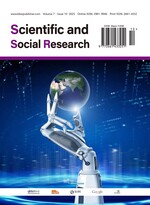Intercultural Communication in Medical Context: An Analysis of Regional and Cultural Factors
Abstract
In recent years, the number of visitors to China has surged. As a result, the number of foreign nationals utilizing China’s healthcare system has inevitably increased. From the perspective of applied linguistics, empirical research on foreign patients’ medical experiences and health examinations in China remains limited. This study, as a preliminary experiment focusing on communication between foreign patients and Chinese doctors, collected 10 short videos shared by foreign patients living in or visiting China, which documented their healthcare experiences. Through transcription and translation, a total of 9,033 words of text were obtained. The transcribed texts were then analyzed for sentiment using the micro-word cloud software. The study found that foreign patients in China praised the efficiency of healthcare services, particularly the ability to undergo tests and examinations without the need to wait for an appointment, as well as the high-quality doctor services, and affordable medical costs. However, concerns about privacy protection were also noted.
References
Tao Y, 2024, From January to July, the Number of Foreign Visitors to China Reached 5.722 Million, Representing a Year-on-year Increase of 403%. Bright Tourism. https://travel.gmw.cn/2024-09/11/content_37556154.htm
Zhang C, Chor W, 2023, Realizing Holism in Traditional Chinese Medicine (TCM) Consultations through the Voice of TCM (VOTCM): An Interactional Analytical Approach. Health communication, 38(2): 275–284. https://doi.org/10.1080/10410236.2021.1950292
Liu X, Zeng J, Li L, et al., 2024, The Influence of Doctor-Patient Communication on Patients’ Trust: The Role of Patient-Physician Consistency and Perceived Threat of Disease. Psychology Research and Behavior Management, 2024(17): 2727–2737. https://doi.org/10.2147/PRBM.S460689
Chen X, Liu C, Yan P, et al., 2025, The Impact of Doctor-patient Communication on Patient Satisfaction in Outpatient Settings: Implications for Medical Training and Practice. BMC Medical Education, 25(1): 830. https://doi.org/10.1186/s12909-025-07433-y
Hall ET, 1976, Beyond Culture. Anchor Books, New York.
Hofstede G, Hofstede GJ, Minkov M, 2010, Cultures and Organizations: Software of the Mind (3rd ed.). McGraw‑Hill, Ohio.
Martin JN, Nakayama TK, 2010, Intercultural Communication in Contexts (5th ed.). McGraw‑Hill, Ohio.
Schouten BC, Meeuwesen L, 2006, Cultural Differences in Medical Communication: A Review of the Literature. Patient Education and Counseling, 64(1–3): 21–34.
Paternotte E, van Dulmen S, van der Lee N, et al., 2015, Factors Influencing Intercultural Doctor-patient Communication: A Realist Review. Patient Education and Counseling, 98(4): 420–445. https://doi.org/10.1016/j.pec.2014.11.018
Alkhamees M, Alasqah I, 2023, Patient-physician Communication in Intercultural Settings: An Integrative Review. Heliyon, 9(12): e22667. https://doi.org/10.1016/j.heliyon.2023.e22667
Jin Y, 2022, Doctor-patient Communication in Chinese and Western Medicine. Routledge, London. https://doi.org/10.4324/9781003161929
Hu Y, Wang W, Jiang Y, et al., 2024, Factors Associated with Family Decision-Making Self-efficacy among Family Members of Patients with Advanced Cancer in Mainland China. Palliative & Supportive Care, 22(5): 1317–1323. https://doi.org/10.1017/S1478951524000658

